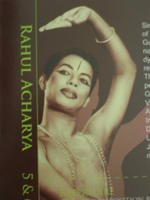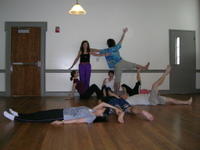Moving into a circular position, they bent from the waist and let their fingers “run” along the floor and through thin air. And before they made their exit, they sidekicked and flung their limbs in all directions, as if unlocking and loosening their bodies.
Weijun, in red sneakers and torn jeans, hogged the red spotlight. This no-music solo section focused on the strength and grace of the body. There was more ballet and contemporary dance vocabulary in this part of the piece. With ease, he jumped and pirouetted, posed in what looked like a bird in mid-flight, and combined both staccato and fluid movements in his upper body.
There is a scene that allowed the dancers to show their individuality; each carried a personal item – tissue paper, pillow, jacket, lipstick, and an orange - and dressed in the attire of their choice. Eden made the stage her bed and “sleep-danced” away with near-impossible elbow stands, back bends, and front splits.
In an elegant voice-led segment, poetry became music. Teresa and Kuan Nam took turns to recite the verses, in English and Mandarin, while the other dancers reacted to them.
In the male duet (Kuan Nam and Steve) that ensued, a different choreographic process took place. The dancers created their own movements using a form of contact improvisation technique. The last “touch” or movement of a dancer triggered the movement of another (dancer). Steve, who is duet-trained, took the opportunity to incorporate some “lifting” moments. Weijun joined them, but too briefly. Hopes for a male trio were dashed as he broke into another solo as the others left the stage.
In interspersing homo- and heterosexual pairing, the dancers played tug-of-war until Loke, the fifth dancer, entered and introduced imbalance and entanglement into the sequence. The music then broke down like a broken record and the bodies contorted to that.
Finally, the dance ended with the same hip hop sequence that it began with. As simple and straightforward as it looked, marrying hip hop and contemporary dance, if not done properly, could have disastrous results.Their union in EN-BODY-MEN was smooth, giving birth to what Weijun called a “pop contemporary dance”.



